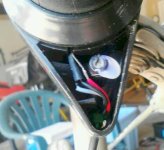wallypedal
100 mW
 More baby steps, the picture is with the old POS brushed gear reduction low watt motor.
More baby steps, the picture is with the old POS brushed gear reduction low watt motor.Thanks for the BMS guidance. The charger, although it says 44 V, is stopping and going green light at 43. I have not seen it put out more than 43 ever. Maybe my RS DMM is inaccurate. Will leave it plugged in 24 hrs anyway. It hit 43 twice today, then I ran it down to 39.5, just to see if cycle activity would kick it beyond 43.0. I want to see if the BMS does balance the cells.
The startup thing is almost a groan with a hint of chatter, and is not very objectionable. It is in time with the motor and the motor itself is much quieter (post-bearing replacement) than it was. Not sure I've got the right combo picked yet on the halls/phases. The motor phase wires are definitely smaller that the controller phase. I don't think with this voltage/watt/amp setup that the motor phase wires are a factor. I am a little concerned about the integrity of all the wires entering the axle. No visual damage and continuity is there in static mode, but the spring and rubber boot going to where there should have been a drip loop were damaged at one time.
Going to do the battery check, get set up to monitor watts/amps/volts while in motion and adding load. I do dislike the cheap white spade type connectors and am curious about the best alternative for hall and phase connectivity. Have yet to learn what "Anderson' connectors are but will find out. Any recommendations in this dept? I'll try not to clutter up the forum until after getting the additional meters and testing done, but I appreciate every bit of help!
Wallypedal


